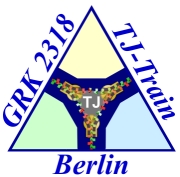
DFG Research Training Group "TJ-Train" (GRK 2318/2) Project
A3
Prof. Dr.
Michael Fromm
Clinical Physiology / Nutritional
Medicine, Campus Benjamin Franklin, Structural conditions of claudin-based water and cation channels Project A3, 2nd cohort: Functional-structural relationship of paracellular channels and barriers formed by claudin-2 and claudin-3 Background: Our group has discovered that clusters of the tight junction (TJ) protein claudin-2 forms paracellular channels for small cations and also for water. In contrast, claudin-3 does not form channels but contributes to barrier function of the TJ. For the present project, we want to examine the interaction and tight junction strand distribution of claudin-2/claudin-2, claudin-3/claudin-3, and potential claudin-2/claudin-3 clusters. For this, we will generate hybrid claudin-2/claudin-3 cluster expressing cell lines and characterize their properties with regard to paracellular permeabilities to different cations and to water, the latter using a proprietary method for measuring water transport in cell culture monolayers.Hypothesis: In vector controls of cell cultures with high claudin-2 expression the TJ properties are mainly determined by the formation of "pure" pores based on claudin-2, which allow cations and water to pass. After claudin-3 transfection, a combined expression and interaction of claudin-2 and claudin-3 should predominate. Although claudin-2/claudin-3 hybrid pores could still be water-permeable they should have a reduced charge density within the pore. This would reduce cation permeability while maintaining water permeability.Work plan: (A) Generation of stable epithelial cell clones with defined high or low claudin-2 expression as controls and additional defined expression rates of claudin-3. (B) Verification of the transfections and validation of the desired constancy of other claudins and aquaporins in the Western blot with densitometric evaluation. (C) Investigation of the localization and clustering of claudin-2 and -3 in a confocal and super-resolution microscope, in parallel to structure modeling studies performed in the partner project A2. (D) Freeze-fracture electron microscopy of tight junction strands of the different clones with subsequent morphometric evaluation. (E) Measurement of water permeability of the generated clones in comparison to the corresponding controls. The general goal of the project is to understand the structural prerequisites for claudin-based water and cation channels.2nd cohort PhD doctoral student Fabián Martínez-Perafán
1st cohort PhD doctoral student Carlos Ayala-Torres
Ayala-Torres C, Krug SM, Schulzke JD, Rosenthal R*, Fromm M* (*shared last authorship) (2019) Tricellulin effect on paracellular water transport. Int. J. Mol. Sci. 20 (22): 5700 (15 pages) [PubMed] [WebPage] [PDF] (IF 4.6) Rosenthal R, Günzel D, Piontek J, Krug SM, Ayala-Torres C, Hempel C, Theune D, Fromm M (2020) Claudin-15 forms a water channel through the tight junction with distinct function compared to claudin-2. Acta Physiol. 228(1): e13334 (15 pages) [PubMed] [WebPage] [PDF] (°IF 6.3) Participation with project A3 Priv.-Doz. Dr. Rita
Rosenthal
Priv.-Doz. Dr. Susanne M. Krug
Project-related publications
|